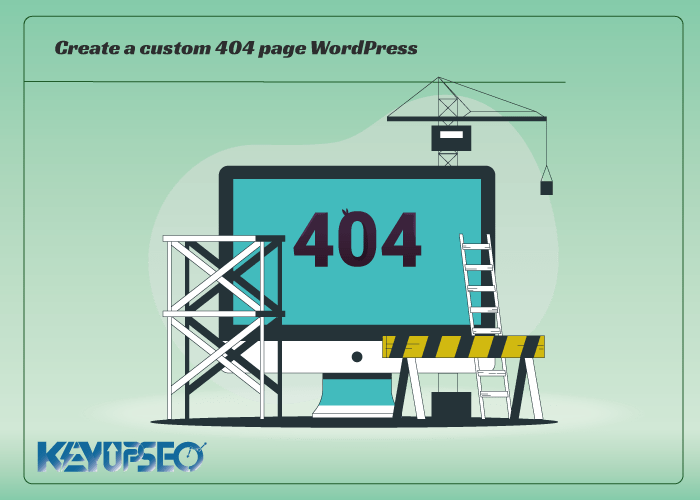
Create a custom 404 page in WordPress with the 404page plugin
The 404page WordPress plugin is a useful plugin for creating a custom 404 page, and we will explain more about it in this article.
The default 404 page of WordPress does not look good, and in the Keyupseo blog, we teach how to create a custom 404 page on WordPress with the 404page plugin.
Since you know that Visit site is one of the most important parameters in site SEO, if you want users not to leave your site after encountering the 404 page, you must create a proper 404 page. As a result, the traffic attracted to the site does not decrease.
First, we will answer some common questions and then continue the training.
What is a 404 error on WordPress?
This error will appear when a page is not found on WordPress. Either the page has been deleted or its address has been changed!
How to fix 404 error?
First, we need to find the problem, then get through it and eliminate the 404 error or display it in a custom way.
Set up a custom 404 page
Depending on your site's theme, you have a few options for using a custom 404 page. Using a plugin to create a custom 404 page should work well with any modern theme. It doesn't matter if your template has a classic editor or gutenberg!
Custom 404 page on WordPress
Maybe the question of many of you is that why should this page have an attractive appearance? Why is it necessary to personalize an error page?
This allows you to maintain the value of your brand and show the user the right path. This means your responsibility in front of the audience! In addition, you can add links to other popular pages such as blogs or send to a section so that the audience does not get lost.
Redirecting users to the home page can also affect your SEO, because Google still sees this redirect as a soft-404 error, so redirects usually don't hide this error from Google.
According to Google, 404 redirects to your home page are a problem. Website owners should always focus on creating user-friendly 404 pages because it is definitely inevitable on any site!
Now that this is clear to you, we need to see how to create a custom 404-page on WordPress.
Using the 404 page of the installed template
If you are comfortable working with your website's PHP files and know how to modify them, many themes will definitely include a template for a 404 page. To view and change it, you can perform the following steps:
- Go to the View Editor section.
- In this section, look for a file named 404.
- This file can be edited and changes can be made in it. You can actually create a custom 404 page on WordPress with it.
This method is recommended for people who are familiar with WordPress codes. If you are not familiar with it, don't worry about it.

Copy file 404
Some themes may not include the 404 file. If you encounter such a case, you can copy a 404 file from another theme, such as Twenty-Twenty, which is the default WordPress theme.
In this case, it may need some changes to match your theme, but you can customize the 404 file and save it in your theme folder. For this purpose, run the following guide:
- Download and receive the 404 file from your desired theme.
- Copy and paste it into your current theme, which is the 404 file.
- Now edit and make the changes you want.
Copy the index.php file
If your template does not have a 404 file, and you don't want to copy it from another theme, there is another way:
- Make a copy of index.php.
- Change its name to 404.
- Remove the code used to display the posts.
- Personalize the texts and insert the desired image.
Creating a 404 page with page builders
If you use page builders like Elementor, you can easily design a custom 404 page on WordPress that is completely exclusive and attractive. I personally recommend this because the result will be great.
Using the 404 page plugin
If you can't do all of the above, you can use the 404 page plugin. In fact, an easy way to add a custom 404 page to any WordPress site is to use a WordPress 404-page plugin. Now, if you agree, let's check how to install and work with this plugin.
This plugin allows you to design custom 404 pages and track 404 errors. Now, to install this plugin, enter the plugins section and install it. After installation, an option called error page 404 has been added from the display section, which is what we are dealing with.
In the menu of the WordPress panel and from the drop-down menu, you can specify the page mode. All the tabs that have been created are available and you can specify it. By clicking on the test 404 error button, it will show you the appearance of the page. It is also possible to edit sheets.
Advanced
This section also has the following settings:
Hide the selected page from the Pages list
- Send an 404 error if the page is accessed directly by its URL
- Force 404 error after loading page
- Disable URL autocorrection guessing
- Send an HTTP 410 error instead of HTTP 404 in case the requested object is in trash
- Always send an HTTP 410 error instead of HTTP 404
- Activate Compatibility Mode
You can use different themes and settings to make your 404 page.
Release date : 13 June, 2023













